Explore the Pyramid of Sahure, an ancient Egyptian marvel in Abusir, showcasing innovative design, intricate reliefs, and a rich cultural legacy.
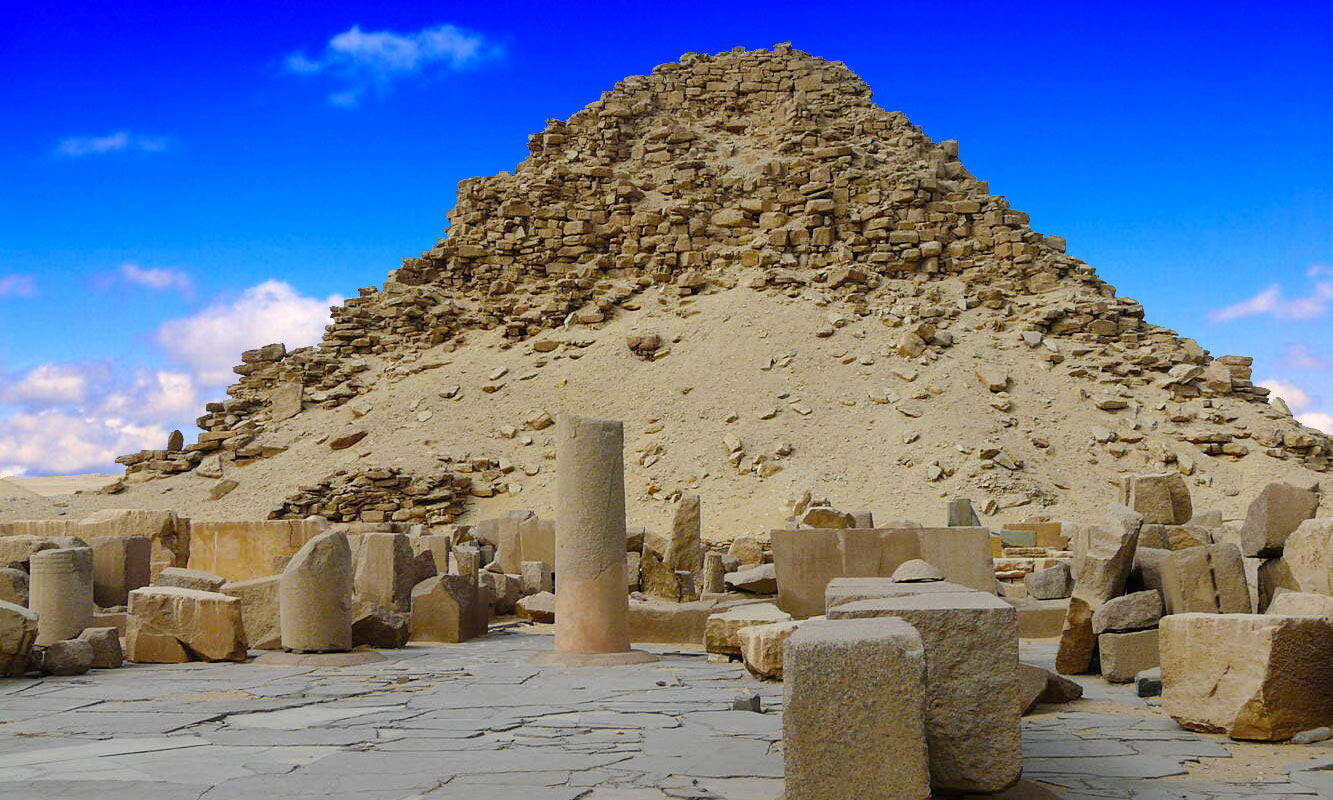
| Overview | |

|
|
| Location | Abusir, Giza Government |
| Material | Limestone |
| Height | 47 m to 48 m |
| Base | 78.5 m to 78.75 m |
| Volume | 96,542 m3 |
| Purpose | Tomb |
The Pyramid Of Sahure is an immortal milestone that changed the face of ancient Egyptian tomb architecture in the golden lands of Abusir. The pyramid complex of Sahure became known as "Sahure's Soul Shines" and is renowned for being the first pyramid ever to be built in the land of Abusir. The pyramid complex was highly significant due to all the brilliant decorative reliefs and construction materials utilized to create an artistic masterpiece.
The pyramid was able to stand the test of time since the 5th dynasty (2465 – 2323 BC) to shed light on the innovation and architectural brilliance, plus explore the history behind the final days of the ancient Egypt old kingdom, which is signified by a noticeable decline in the building methods. The funerary complex was filled with many elements which, with time, became a standard in all the future projects of Egypt.
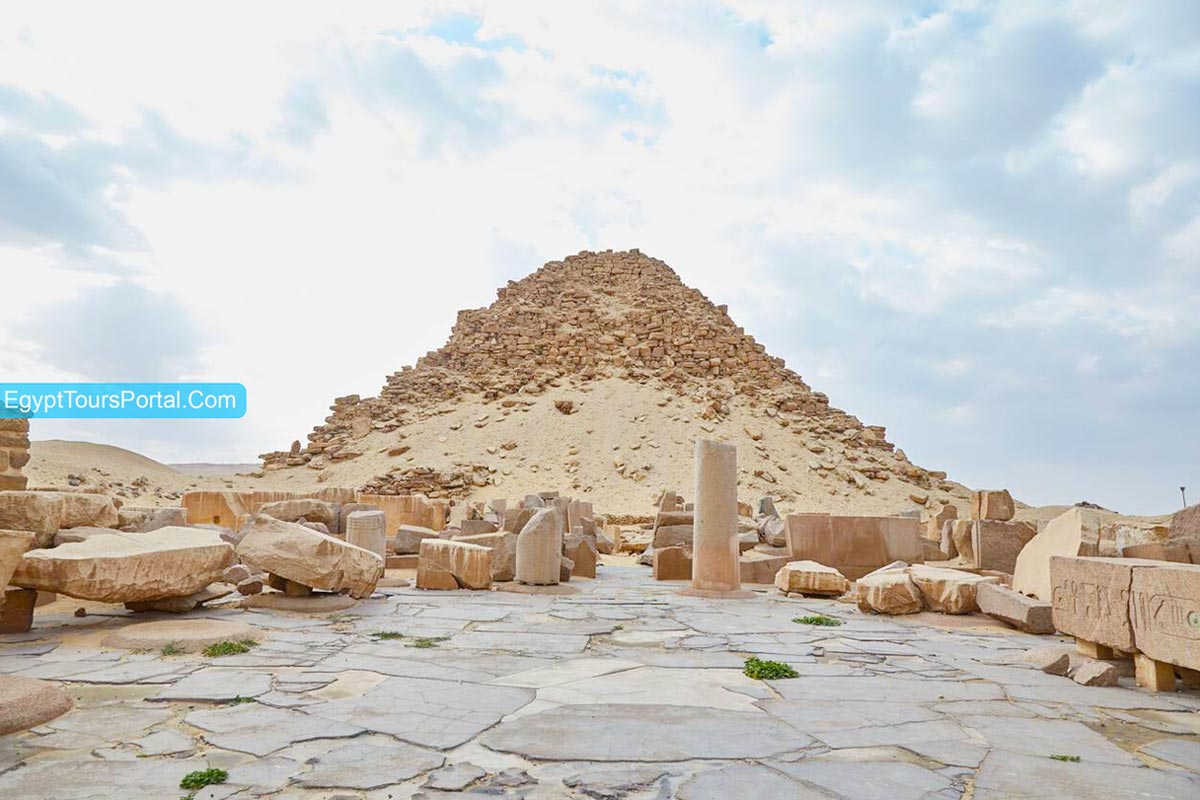
The pyramid of Sahure was constructed around 4,500 years ago and was a significant complex dedicated to the pharaoh Sahure of Ancient Egypt's Fifth Dynasty. It was built in Abusir as the first pyramid in the area which kickstarted a phase of pyramid construction by Sahure's successors, following the layout established by Userkaf's earlier sun temple. The pyramid is known by the name of "Khai-ba Sahura" which is translated into "Sahure's Soul Shines" or "The Ba of Sahure Appears" and "The Rising of the Ba Spirit of Sahure". It was excavated in the early 20th century which later set a blueprint for later pyramid structures of the Fifth and Sixth Dynasties. Compared to prior Fourth Dynasty pyramids, Sahure's construction was smaller in scale, but it boasted a richer decoration scheme and expanded temple areas. His mortuary temple later became a focal point for the worship of the goddess Sekhmet, who was worshipped from the Eighteenth Dynasty through the Ptolemaic Kingdom. While neighboring monuments faced destruction in various phases, Sahure's complex remained relatively intact, possibly due to the enduring presence of this cult.
The pyramid of Djedefre was considered to be one of the most beautiful of all the pyramids. Read more facts about the Djedefre pyramid.
Read MoreThe monuments of the pyramid complex of Sahure later resurged during different Egyptian dynasties, with reliefs from Sahure's temple copied for use in other structures. Despite waves of destruction during the Twenty-Seventh Dynasty and later under Roman rule, Sahure's temple escaped significant harm. It even transformed into a Coptic shrine in the early Christian era, evidenced by the discovery of pottery and graffiti dating between the 4th and 7th centuries AD. From the late 19th century till the present moment, the monuments faced periodic quarrying for their limestone.
Sahure picked a spot near Abusir for his memorial, which became the area's first pyramid. Userkaf was the Fifth Dynasty's founder who selected Abusir for his sun temple, though reasons for this choice remain uncertain. It might have been linked to the nearby Ra cult or the sight of the gilded pyramidion from Heliopolis.
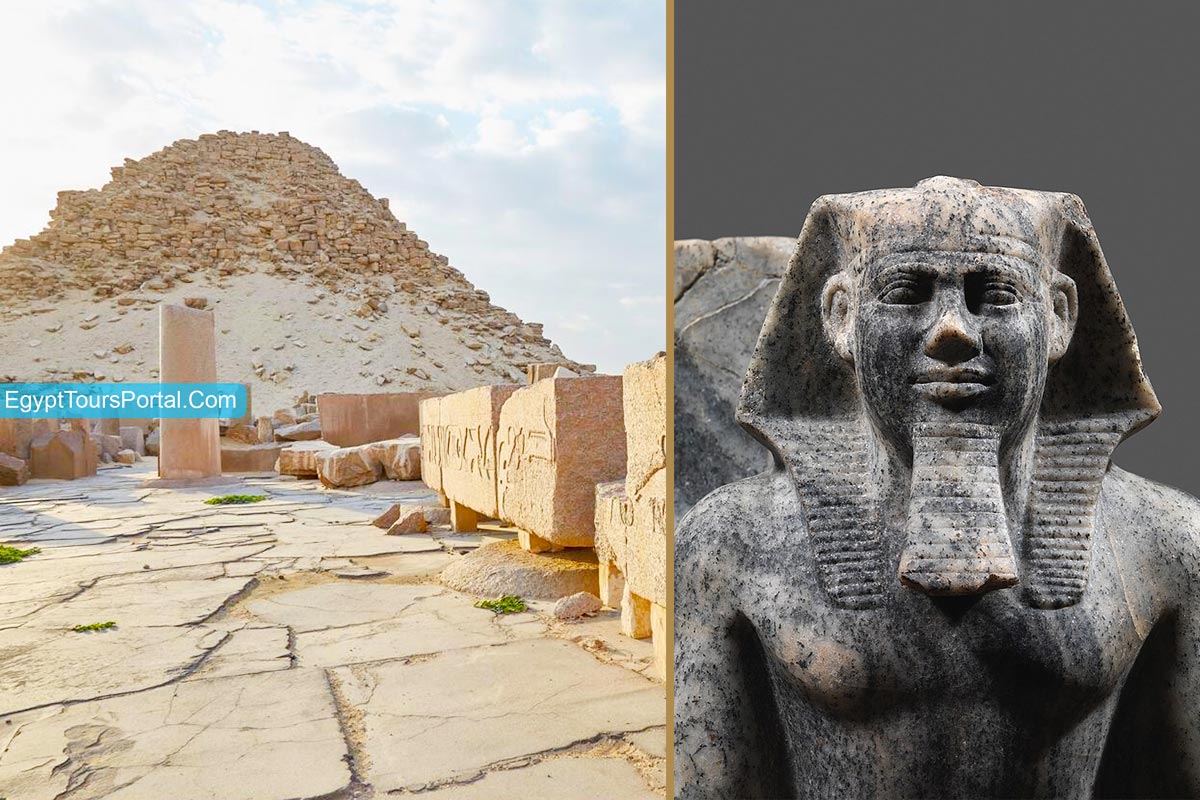
Sahure was an ancient Egyptian pharaoh of the 5th Dynasty who ruled for about 13 years during the early 25th century BC, a period regarded as the peak of the dynasty's political and cultural influence. His legacy encompasses remarkable achievements in trade, maritime exploits, architectural innovation, and the lasting impact of his funerary cult on Egyptian religious practices. He likely succeeded his father, Userkaf, and was followed by his son, Neferirkare Kakai. Sahure's reign was marked by significant trade with the Levantine coast, where he led naval expeditions for cedar trees, slaves, and rare goods. He boasted an Egyptian navy and orchestrated the earliest known expedition to the land of Punt, acquiring valuable items like myrrh, malachite, and electrum. Unique reliefs from his mortuary temple depict him gardening, showcasing the success of these endeavors. He also commanded expeditions to Sinai's turquoise and copper mines and engaged in military campaigns against Libyan leaders in the Western Desert, bringing back incredible spoils to Egypt.
Sahure departed from tradition by constructing his pyramid complex in Abusir instead of the royal necropolises of Saqqara and Giza. His pyramid, though smaller than the Fourth Dynasty's, featured elaborate architecture and over 10,000 square meters of vibrant polychrome reliefs, setting a high artistic standard. Innovations in architecture, such as palmiform columns and the layout of his mortuary temple, became benchmarks in ancient Egyptian construction. He established a funerary cult that endured beyond his reign, sustained by agricultural estates. While his cult's significance dwindled in the Middle Kingdom, during the New Kingdom, Sahure was associated with the goddess Sekhmet, leading to a dedicated cult that persisted for nearly 2500 years after his death, attracting devotees from across Egypt.
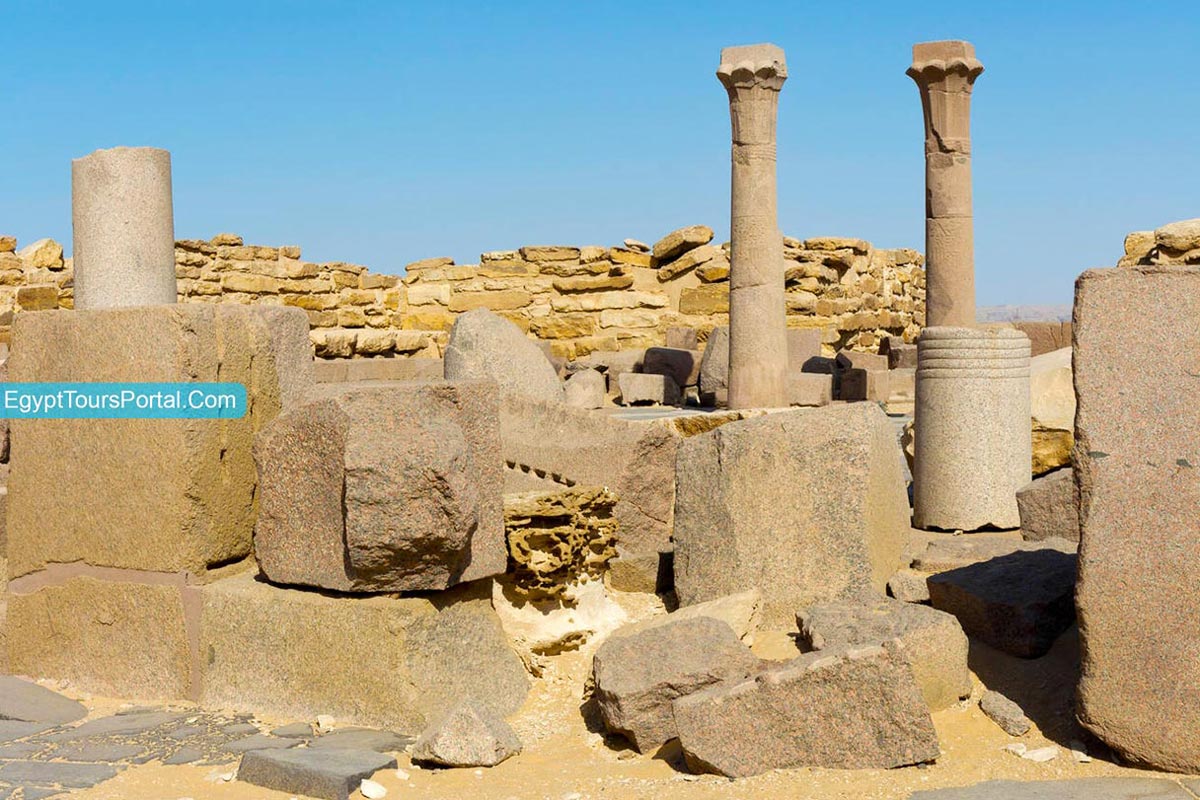
The Sahure complex was an artistic marvel that was adorned with intricate relief carvings covering about 10,000 square meters of walls, though only 150 square meters have survived. Among these, a remarkable hunting scene spanning 8 meters by 3 meters stood out, considered unparalleled in ancient Egyptian art. Sahure's temple had 370 meters of relief, while Khufu's Great Pyramid had 100 meters. It was constructed from limestone blocks and encased in fine white Tura limestone. The main pyramid stood around 78.5 to 78.75 meters long and between 47 and 48 meters tall, showcasing an architectural flaw due to an eastward extension error. The internal chambers were plundered, hindering accurate reconstruction. Fragments of a basalt sarcophagus were the only remnants of the king's burial found. The pyramid core was composed of six steps of limestone being held together with mud mortar, with an entrance to the north encased with fine white limestone.
A short passage descends from the entrance to a small hallway, and a heavy pink portcullis behind the corridor rises towards the antechamber. The internal passages were lined with granite, and the king's burial chamber contained a gabled roof supported by three limestone beams. Both the burial chamber and the antechamber were badly damaged, and the only minor fragments of the basalt sarcophagus were found in the burial chamber.
Next to the pyramid's east face, the mortuary temple featured various chambers like an entrance hall, statue chapel, offering hall, and storerooms, a design echoing earlier temple layouts. A smaller cult pyramid and a meticulously adorned causeway that spanned 235 meters linked the two temples together. The valley temple, which is situated by Abusir Lake, was distinctive with dual entrances; the purpose of the second entry remains unclear but might have connected to a nearby pyramid town. The use of valuable materials like granite, alabaster, and basalt showcased the opulence of Sahure's complex despite the challenges of preserving its original grandeur.
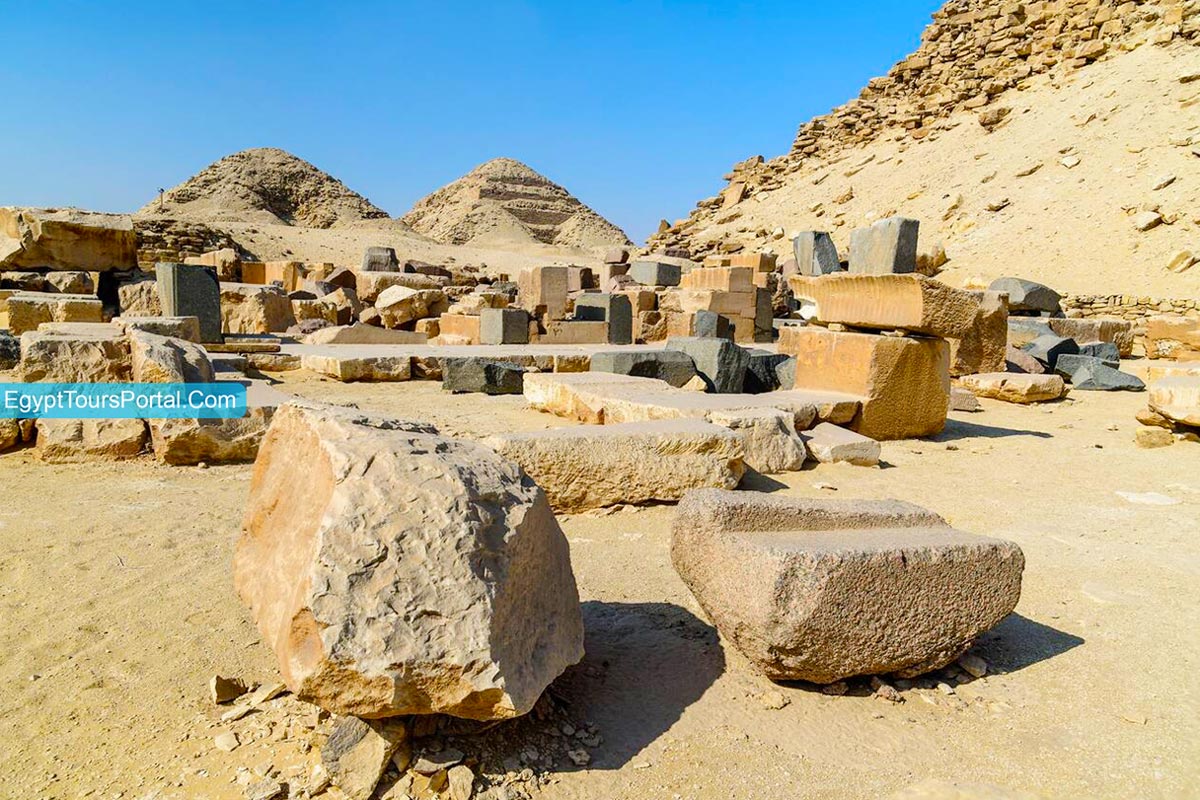
During the Old Kingdom in ancient Egypt, the mortuary complexes for rulers typically comprised five key parts: a valley temple, causeway, mortuary temple, cult pyramid, and the main pyramid. Sahure's complex was a prime example, containing all these elements. His main pyramid was around 47 meters tall, built with six steps of stone covered in fine white limestone. Adjacent to it was a cult pyramid at the southeast corner and a mortuary temple next to its eastern face. These are connected to a valley temple by a lengthy causeway situated on Abusir Lake.
In the Fifth Dynasty, changes occurred in pyramid construction; pyramids became smaller with simpler building methods. However, there were improvements in relief decorations on walls and the expansion of storage spaces in temples. Sahure's complex set a template for future Fifth and Sixth Dynasty complexes. His mortuary temple layout became the standard for later similar temples in the Old Kingdom, marking a significant milestone in the development of pyramid complexes.
Sahure's complex was extensively adorned with relief decorations, considered some of the finest in the Old Kingdom. The walls featured around 10,000 square meters of finely carved relief, with his mortuary temple alone having 370 meters of these decorations. Comparatively, earlier and later ancient Egyptian kings had fewer relief decorations in their temples, indicating a decline in this artistic expression after Sahure's reign.
Sahure's temple also allocated a significant area for storerooms, showing a shift in focus toward the practical aspects of the mortuary cult's daily activities. While earlier temples had minimal or no space for storerooms, Sahure dedicated about 21.6% of his mortuary temple's area to these functional spaces, emphasizing their importance. This change reflects a shift in priorities within the mortuary cult's rituals and operations.
Sahure's pyramid rests atop a hill that stands 20 meters (66 feet) on top of the Nile valley. Unlike its predecessors, this pyramid wasn't carved into bedrock but was built upon a platform made of layered limestone. The core of the pyramid, originally featuring six steps, now retains five, likely fashioned from horizontally arranged limestone blocks. This core was primarily composed of roughly cut low-grade limestone held together by mud mortar and encased in a fine layer of white limestone. Its construction diverged notably from earlier pyramids. Large, roughly dressed grey limestone blocks were used for the outer faces, connected firmly with mortar, while smaller blocks framed the inner chambers. The space between these frames was filled with a mix of pottery shards, limestone chips, and sand held in place by clay mortar. This method expedited construction but compromised stability, resulting in only the pyramid’s outer casing being made of high-quality limestone.
Precise details regarding dimensions and appearance remain somewhat uncertain due to the pyramid's deteriorated condition. The base's length ranged between approximately 78.5 to 78.75 meters (258 to 258.4 feet), meeting at an angle of around 50 degrees and standing at a height between 47 to 48 meters (154 to 157 feet). An error in marking caused one corner to extend beyond, making the base irregular. During construction, a trench on the north face offered the chance for workers to build inner sections before filling it with rubble. Surrounding the pyramid is a courtyard paved with limestone, except for the place where the mortuary temple stands. This courtyard is enclosed by a rounded tall wall, measuring approximately 3.15 meters (10.3 feet) at its thickest points.
The access point to the substructure of the pyramid is situated slightly above ground level on its north face. A short passage, lined with granite, leads to a vestibule protected by a pink granite portcullis. The corridor beyond is flanked by granite walls and continues with a slope, transitioning from granite to limestone, before reaching its end. The substructure's layout remains uncertain due to severe damage caused by stone thieves. Initially, there were conflicting reports about the funerary apartment, whether it consisted of one or two chambers. However, clearance work in 2019 revealed two rooms, with the burial chamber yet to be fully explored.
The antechamber occupies about 160 square feet, aligns with the pyramid's vertical axis, and leads to the burial chamber. These spaces had ceilings made of three layers of limestone blocks designed to distribute the weight of the structure and prevent collapses. Some of the largest limestone blocks were massive, but most have been damaged or broken over time. Among the ruins, fragments of stone believed to be parts of the king's basalt sarcophagus were discovered, representing the only remains found within the apartment.
Sahure's valley temple, found by Abusir Lake on the desert's edge, is now in ruins. Its rectangular shape, originally 105 feet long by 79 feet wide, faced north-south but now lies about 16 feet below current ground level due to Nile flood silt accumulation. This temple boasted two entrances: an elaborate eastern one with a column-adorned portico, polished basalt flooring, and decorated walls and ceiling portraying the entrance into the "Duat". The columns were designed like date palms with painted capitals showcasing the king's name. A secondary entrance on the south side led to a less adorned portico with cylindrical columns lacking decorative crowns, the purpose of which remains unclear.
The passages on the inside are connected to these entrances to a T-shaped hall with two columns, decorated originally with colorful reliefs depicting Sahure as a sphinx or griffin triumphing over Near Eastern and Libyan enemies. This hall is linked to additional rooms, one with a staircase to the roof terrace and a causeway at its far end. Sahure's depiction of soldiers differed from Userkaf's; Sahure's soldiers displayed uniform postures, while Userkaf's scene presented more dynamic but complex imagery. Sahure's artisans compensated for uniformity by adding intricate details to the soldiers' musculature and facial features, balancing the scene's monotony.
Sahure's causeway is a 771-foot "235 m" long limestone structure that is linked to the valley temple all the way to the mortuary temple. It was roofed which allowed slivers of light through the ceiling, lighting its walls adorned with colorful bas-reliefs. These depicted the king as a sphinx vanquishing enemies, scenes of offerings, animal rituals, and the transport of the pyramidion. One intriguing scene portrayed emaciated nomads, initially thought unique to Unas' causeway, suggesting Saharan nomads' hardship during the Sahara's decline. However, the same scene in Sahure's causeway raises doubt, hinting these nomads might symbolize the toil of builders bringing high-quality stone from distant mountains.
Another scene displayed Sahure with his family in a palace garden, confirming the identity of his consort, Meretnebty, plus his twin sons, Ranefer and Netjerirenre. Ranefer, possibly Neferirkare Kakai, held closer to Sahure, while Netjerirenre might be Shepseskare. A crucial relief showed a ship procession, possibly Egypt's earliest voyage to Punt, known for myrrh, electrum, and wood. Sahure was depicted extracting resin from a tree, likely Boswellia, not myrrh, and later feasting with his family near these trees. This discrepancy challenges the notion that the depicted trees were Commiphora myrrha, suggesting they might indeed be Boswellia frankincense, owing to the color of the resin and the tool used for extraction.
There are many secret facts about the Pyramids, the theories of construction the Pyramids and more, open our article to read more about them.
Read MoreSahure's mortuary temple was an architectural wonder and a complex space steeped in religious significance, reflecting the grandeur and meticulousness of ancient Egyptian construction and spiritual practices. Sahure's mortuary temple was a grand structure aligned along an east-west axis, situated in front of his main pyramid. Constructed primarily from limestone but adorned with valuable materials like granite and alabaster, the temple stood as a blueprint for future designs during the Old Kingdom. It had an entrance hall transitioning from the causeway, though much of its original state is now lost. This hall likely mirrored the reception space in royal palaces. Beyond it, a corridor adorned with vivid reliefs depicting the king hunting and scenes of order amidst the wilderness led to an open courtyard. This courtyard featured granite columns, each symbolizing fertility and carrying inscriptions of the king's name.
Detailed reliefs on its walls depicted the king's victories, even specifying captured spoils like cattle and sheep. Further within was a transverse corridor separating public and private areas, showcasing scenes of maritime expeditions. The corridor led to a statue chapel, a crucial religious space housing statues, each representing different facets of the king's identity. The offering hall was crucial in the temple's mortuary rituals as it contained ornate bas-reliefs of deities offering to the king. An unusual false door here lacked expected inscriptions, sparking speculation about potential theft. The temple had an intricate drainage system that employed copper piping to manage rainwater and ritual liquids. Stone lion-head spouts on the outer walls funneled rainwater, which also symbolically wards off any kind of harmful evil spirit.
There's a smaller cult pyramid located near the southeast corner of the main pyramid, which has an enclosed area. This space can be entered either through the southern part of the transverse corridor or a portico at the side entrance of Sahure's mortuary temple. This portico is quite elaborate, with basalt flooring and colorful reliefs showing deities and symbols giving blessings to the king. Beyond this area, there's a room leading either to the transverse corridor or to an oblong room just before the cult pyramid in the south. The cult pyramid is known to be smaller compared to the main one, which was constructed with a core made of limestone block debris that is surrounded by yellow limestone blocks and covered with white limestone blocks, which is similar to the main pyramid's structure.
It measured 15.7 meters in base length, narrowing towards the top at a height of 11.6 meters. Inside, there's a corridor on the north side leading to a burial chamber slightly below ground level. This chamber was found empty and damaged, likely due to tomb raiders. The cult pyramids likely served a symbolic role, possibly containing the pharaoh's spirit or a small statue. It might have been crucial for ritual ceremonies associated with the burial and revival of the spirit during ceremonial occasions. Also, there's an unexplored burial ground accessible through the southern end of the transverse corridor, believed to be where Sahure's consort, Meretnebty, and son, Netjerirenre, are known to be buried.
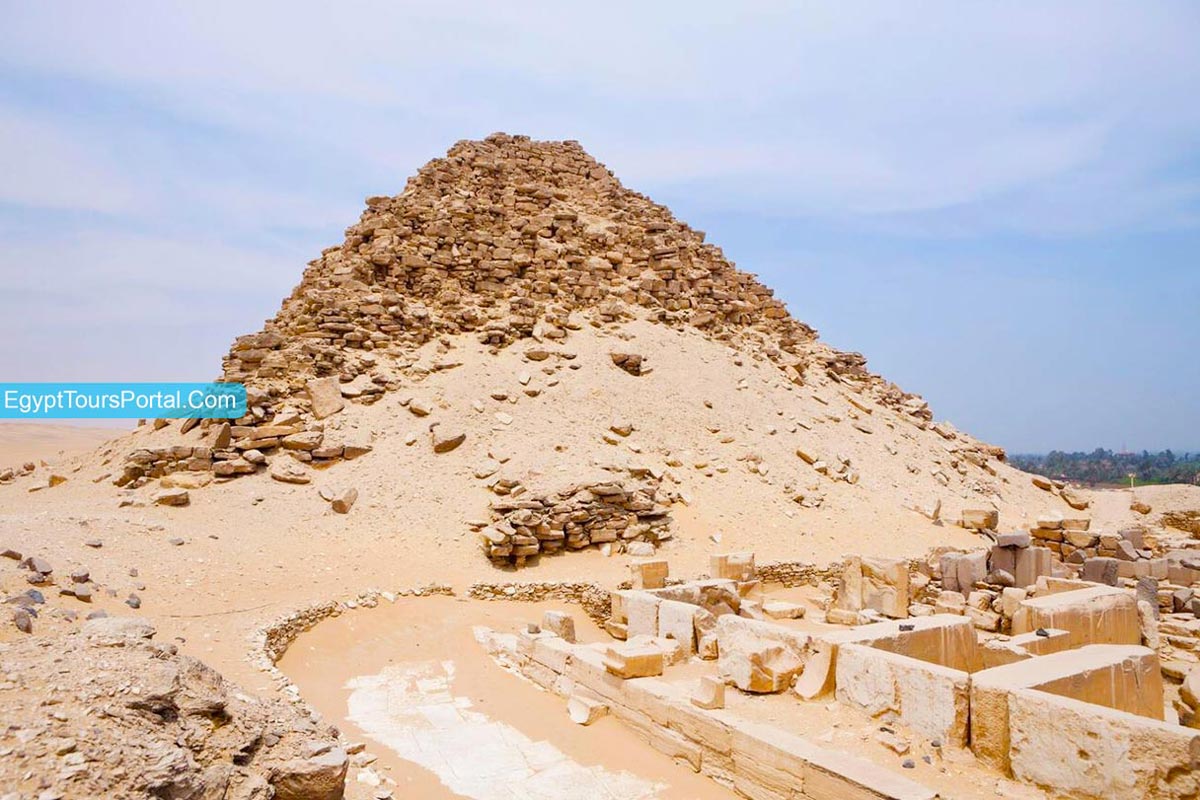
Behind every pyramid is a story waiting to reveal itself to a true traveler, take the once-in-a-lifetime chance to explore this beautiful heavenly land through our Egypt pyramids tour packages.
Private 4 Days Cairo Tour Packages 4 days Cairo Egypt tour package will offer a bles...
Tour Location: Cairo – Giza...
Stunning 5 Days Cairo and Alexandria Tour Package 5 days Cairo and Alexandria tour p...
Tour Location: Cairo/Giza/Alexandria...
Exceptional 6 Days Cairo, Luxor & Aswan Tour Package 6 days Cairo, Luxor & A...
Tour Location: Cairo/Giza/Aswan/Luxor...
Amazing 7 Days Cairo and Hurghada Holiday 7 Days Cairo & Hurghada holiday will e...
Tour Location: Cairo – Giza – Hurgh...
The entire country of Egypt deserve to be explored with its every heavenly detail but there are places that must be seen before any other such as the breathtaking Hurghada's red sea, The wonders of Cairo the pyramids of Giza, the great sphinx, the Egyptian Museum, Khan El Khalili Bazaar, the wonders of Luxor like Valley of the Kings, Karnak & Hatshepsut temple and the wonders of Aswan such as Abu Simbel temples, Philea temple, Unfinished obelisk and The Wonders of Alexandria like Qaitbat Citadel, Pompey's Pillar and Alexandria Library. Read more about the best places to visit in Egypt.
If you want to apply for a Visa On Arrival that lasts for 30 days then you should be one of the eligible countries, have a valid passport with at least 6 months remaining and pay 25$ USD in cash, as for the E-Visa for 30 day you should have a valid passport for at least 8 months, complete the online application, pay the e-visa fee then print the e-visa to later be presented to the airport border guard. You could also be one of the lucky ones who can obtain a free visa for 90 days. Read more about Egypt travel visa.
Egypt has a variety of delicious cuisines but we recommend “Ful & Ta’meya (Fava Beans and Falafel)”, Mulukhiya, “Koshary”, a traditional Egyptian pasta dish, and Kebab & Kofta, the Egyptian traditional meat dish.
The best time to travel to Egypt is during the winter from September to April as the climate becomes a little tropical accompanied by a magical atmosphere of warm weather with a winter breeze. You will be notified in the week of your trip if the Climate is unsafe and if any changes have been made.
You should pack everything you could ever need in a small bag so you could move easily between your destinations.
We have been creating the finest vacations for more than 20 years around the most majestic destinations in Egypt. Our staff consists of the best operators, guides and drivers who dedicate all of their time & effort to make you have the perfect vacation. All of our tours are customized by Travel, Financial & Time consultants to fit your every possible need during your vacation. It doesn't go without saying that your safety and comfort are our main priority and all of our resources will be directed to provide the finest atmosphere until you return home.
You will feel safe in Egypt as the current atmosphere of the country is quite peaceful after the government took powerful measures like restructuring the entire tourist police to include all the important and tourist attractions in Egypt. Read more about is it safe to travel to Egypt.
Wear whatever feels right and comfortable. It is advised to wear something light and comfortable footwear like a closed-toe shoe to sustain the terrain of Egypt. Put on sun block during your time in Egypt in the summer to protect yourself from the sun.
The best activity is by far boarding a Nile Cruise between Luxor and Aswan or Vise Versa. Witness the beauty of Egypt from a hot balloon or a plane and try all the delicious Egyptian cuisines and drinks plus shopping in old Cairo. Explore the allure and wonders of the red sea in the magical city resorts of Egypt like Hurghada and many more by diving and snorkeling in the marine life or Hurghada. Behold the mesmerizing western desert by a safari trip under the heavenly Egyptian skies.
There are a lot of public holidays in Egypt too many to count either religious or nation, the most important festivals are the holy month of Ramadan which ends with Eid Al Fitr, Christmas and new years eve. Read more about festivals & publich holidays in Egypt.
Egypt is considered to be one of the most liberal Islamic countries but it has become a little bit conservative in the last couple of decades so it is advised to avoid showing your chest, shoulders or legs below the knees.
Arabic is the official language and Most Egyptians, who live in the cities, speak or understand English or at least some English words or phrases. Fewer Egyptians can speak French, Italian, Spanish, and German. Professional tour guides, who work in the tourism sector, are equipped to handle visitors who cannot speak Arabic and they will speak enough English and other languages to fulfill the needs of all our clients.
The fastest way is a car, of course, a taxi. If you are in Cairo ride a white taxi to move faster or you could board the fastest way of transportation in Egypt metro if the roads are in rush hour.
The temperature in Egypt ranges from 37c to 14 c. Summer in Egypt is somehow hot but sometimes it becomes cold at night and winter is cool and mild. The average of low temperatures vary from 9.5 °C in the wintertime to 23 °C in the summertime and the average high temperatures vary from 17 °C in the wintertime to 32 °C in the summertime. The temperature is moderate all along the coasts.
It is the home of everything a traveler might be looking for from amazing historical sites dating to more than 4000 years to enchanting city resorts & beaches. You will live the vacation you deserve as Egypt has everything you could possibly imagine.









